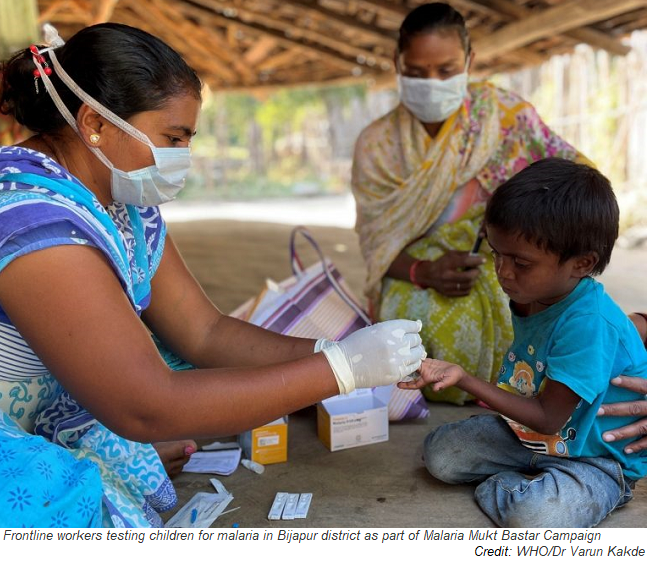With the COVID-19 pandemic restricting access to health facilities, health care workers and frontline workers took health services to the community in the heavily forested districts of Bijapur, Dantewada and Sukma in the Left-Wing Extremism (LWE)-affected Baster region in the state of Chhattisgarh.

Frontline workers tested children for malaria in Bijapur district under make-shift camps and went door-to-door in remote areas under the Malaria Mukt Bastar Campaign (Malaria Free Bastar Campaign) to ensure no child was missed.
Separate fever clinics were established outside health facilities to protect health workers from exposure to COVID-19 and minimized the impact of the pandemic on healthy systems. A health call centre was also established in Dantewada with WHO-supported to ensure uninterrupted essential health services to the community.
WHO is providing technical expertise to the districts of Bijapur, Dantewada and Sukma in the Bastar region as part of its support to the state government of Chhattisgarh to reinforce the Health and Wellness Centre (HWC) programme. This is part of WHO’s assistance to support equitable access to health services at sub-national levels through strengthening of local health systems, including primary health care, with a focus on marginalized groups. This included strengthening of HWC-Bedre in Bijapur and SHC-Hiroli in Dantwada, and setting up of cold-chain points in difficult-to-reach HWC-PHC-Chintalnar and PHC-Jagargunda in Sukma.
Since early 2019, WHO India has provided technical support to around 50% of existing sub health centres in all three districts to be revitalized and upgraded to Health and Wellness Centres, which have become pivotal in providing uninterrupted essential health services during the pandemic.
WHO provided planning and mentoring support for the reorganization of health services to improve efficiencies of auxiliary nurse midwives, rural medical assistants and community health officers on active surveillance and infection prevention and control protocols.
Training auxiliary nurse midwives and community health officers led to an increase in the frequency of home visits for COVID-19 surveillance and other health needs, including noncommunicable diseases (NCDs). Around 8% of men and 7% of women age 15-49 years in the region showing early symptoms of hypertension and diabetes.
LWE, combined with dense forests, had made many of the areas unserviceable by health care workers, which has resulted in region having some of the poorest health indicators in the country. Meticulous planning and wide-scale collaboration between district administration, local community, village leaders and frontline health workers, took primary health care to the remotest of areas even during the lockdown. Service delivery at sub-health centres in Bedre in Bijapur, Hiroli in Dantewada, and Gachanpalli, Kolaiguda and Minpa in Sukma were revived and strengthened after remaining non-functional for nearly two decades.

“From technical support to capacity building, WHO’s support has been indispensable. Collaboration with WHO facilitated strengthening of district health systems for delivering essential health services during the pandemic in addition to the operationalization of quarantine centres, fever clinics, and a dedicated COVID-19 hospital,” said Dr Chandra Bhan Prasad Bansod, Chief Medical and Health Officer and Civil Surgeon, Sukma.
The unprecedented challenges brought by the pandemic galvanized and accelerated solid local action to strengthen primary health care services. This has built the foundation for UHC to ensure that everyone, even those living in the remotest of places, are not left behind.
